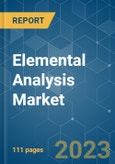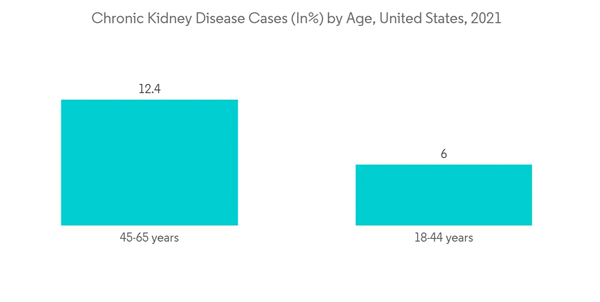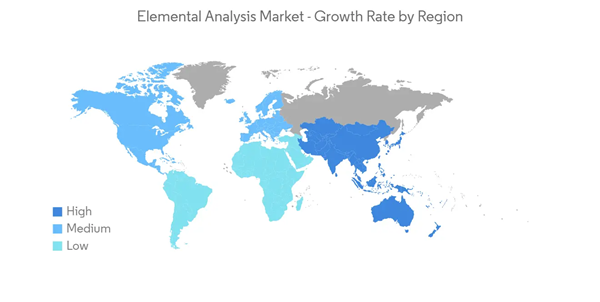The elemental analysis market is expected to register a CAGR of 6.2% over the forecast period.
The elemental analysis market was significantly impacted by the COVID-19 pandemic. In the case of COVID-19 patients, there was an abnormal amount of trace elements in the body, and the respiratory system was at risk of infection due to the higher concentrations of heavy metals in the blood. For instance, as per the study report published by the American Journal of Analytical Chemistry in May 2021, the elemental analysis in COVID-19 patients was performed using an atomic absorption (AA) spectrophotometer, which revealed that COVID-19 patients have abnormal levels of essential trace metals (zinc, iron, and copper) versus toxic elements (cadmium and nickel) in the biological samples. As a result of the COVID-19 effect on elements in the bloodstream, the demand for elemental analysis was significant, which drove the market's growth during the pandemic phase. Currently, the number of COVID-19 cases is relatively low throughout the world; its impact on the market is stable, and the trend is expected to continue due to the ongoing research activities on COVID-19 and emerging viral strains, as per the analysis.
Over the forecast period, the major growth drivers of the elemental analysis market are growing research and development funding in life sciences and mandated government regulations for elemental analysis of pharmaceutical and healthcare products. According to the National Institutes of Health (NIH), Estimates of Funding for Various Research Categories in 2022, it is estimated that the clinical research funding under the life sciences in the United States for 2021 was USD 17,681 million, and it is expected to increase to USD 18,405 million in 2022 and USD 18,383 million in 2023. Thus, the gradual rise in research and development funding is expected to positively impact the market over the forecast period, as elemental analysis is one of the techniques used in clinical research for testing samples of body fluids.
Furthermore, in August 2022, Analytik Jena published that, in a few years, Germany's legislation will make phosphorus recovery from sewage sludge mandatory. The Analytik Jena PlasmaQuant 9100 ICP-OES instrument detects the included nutrients and essential elements in a single measurement cycle, eliminating the need for time-consuming analysis.
However, a lack of skilled personnel is expected to restrain the elemental analysis market's growth during the forecast period.
For instance, according to the study report published by Analytical Letters Taylor & Francis in May 2021, patients with chronic kidney disease (CKD) have compromised kidney function, which affects impurity excretion. These impurities in medications were analyzed using HR-CS GFAAS, and all the products contained Cd, Cu, and Mo within the maximum allowed limits. Hence, inorganic elemental analysis plays a major role in the industry's drug manufacturing, which will drive the growth of the segment over the study period.
Also, according to the study report published by Biological Trace Element Research in September 2021, the circulatory levels of trace elements were analyzed using inductively coupled plasma mass spectrometry (ICP-MS) and it was found that levels of Al, Mn, Co, Ni, Cu, As, Se, Sr, and Pb were higher, while levels of Cr, Zn, Rb, Cd, and U were lower in hemodialysis patients. Hence, inorganic elemental analysis plays a major role in clinical settings, which can rule out the elemental levels in the bloodstream.
Thus, inorganic elemental analysis in industrial and clinical settings significantly drives the segment's growth in the study period.
The essential elements are severely altered in chronic kidney disease (CKD) patients with decreased levels of micronutrients such as zinc, selenium, iron, and calcium. Hence, with the rise in CKD cases, the demand for diagnosing the elements in the bloodstream increases, thereby having a significant impact on the elemental analysis market.
For instance, as per the CDC report, in 2021, 15% of United States adults, or 37 million people, are estimated to have CKD. As a result, the significant number of CKD cases increases the demand for elemental analysis, as CKD is associated with changes in trace elements in the bloodstream. Also, new product approvals and launches help the market grow in this region. For instance, in October 2020, Analytik Jena launched its new version of the ASpectMS operating software for Analytik Jena's PlasmaQuant MS series ICP-MS systems. The updated version also contains 21 CFR Part 11 compliance, improvements to user assistance, report functionality, and optimizations for plasma performance when using organic materials.
Hence, owing to the above-mentioned factors, the North American region is expected to witness high growth over the forecast period.
This product will be delivered within 2 business days.
The elemental analysis market was significantly impacted by the COVID-19 pandemic. In the case of COVID-19 patients, there was an abnormal amount of trace elements in the body, and the respiratory system was at risk of infection due to the higher concentrations of heavy metals in the blood. For instance, as per the study report published by the American Journal of Analytical Chemistry in May 2021, the elemental analysis in COVID-19 patients was performed using an atomic absorption (AA) spectrophotometer, which revealed that COVID-19 patients have abnormal levels of essential trace metals (zinc, iron, and copper) versus toxic elements (cadmium and nickel) in the biological samples. As a result of the COVID-19 effect on elements in the bloodstream, the demand for elemental analysis was significant, which drove the market's growth during the pandemic phase. Currently, the number of COVID-19 cases is relatively low throughout the world; its impact on the market is stable, and the trend is expected to continue due to the ongoing research activities on COVID-19 and emerging viral strains, as per the analysis.
Over the forecast period, the major growth drivers of the elemental analysis market are growing research and development funding in life sciences and mandated government regulations for elemental analysis of pharmaceutical and healthcare products. According to the National Institutes of Health (NIH), Estimates of Funding for Various Research Categories in 2022, it is estimated that the clinical research funding under the life sciences in the United States for 2021 was USD 17,681 million, and it is expected to increase to USD 18,405 million in 2022 and USD 18,383 million in 2023. Thus, the gradual rise in research and development funding is expected to positively impact the market over the forecast period, as elemental analysis is one of the techniques used in clinical research for testing samples of body fluids.
Furthermore, in August 2022, Analytik Jena published that, in a few years, Germany's legislation will make phosphorus recovery from sewage sludge mandatory. The Analytik Jena PlasmaQuant 9100 ICP-OES instrument detects the included nutrients and essential elements in a single measurement cycle, eliminating the need for time-consuming analysis.
However, a lack of skilled personnel is expected to restrain the elemental analysis market's growth during the forecast period.
Elemental Analysis Market Trends
Inorganic Elemental Analysis Dominate the Global Elemental Analysis Market During the Forecast Period
Inorganic elemental analysis involves a variety of analytical methods that can qualitatively or quantitatively determine the inorganic and elemental composition of solids, liquids, aqueous solutions, chemical mixtures, materials, or products. Inorganic components include cations, metals, anions, and inorganic salts. The inorganic impurities or elements do not provide any therapeutic benefit to humans and can also compromise the safety, efficacy, and quality of pharmaceutical products.For instance, according to the study report published by Analytical Letters Taylor & Francis in May 2021, patients with chronic kidney disease (CKD) have compromised kidney function, which affects impurity excretion. These impurities in medications were analyzed using HR-CS GFAAS, and all the products contained Cd, Cu, and Mo within the maximum allowed limits. Hence, inorganic elemental analysis plays a major role in the industry's drug manufacturing, which will drive the growth of the segment over the study period.
Also, according to the study report published by Biological Trace Element Research in September 2021, the circulatory levels of trace elements were analyzed using inductively coupled plasma mass spectrometry (ICP-MS) and it was found that levels of Al, Mn, Co, Ni, Cu, As, Se, Sr, and Pb were higher, while levels of Cr, Zn, Rb, Cd, and U were lower in hemodialysis patients. Hence, inorganic elemental analysis plays a major role in clinical settings, which can rule out the elemental levels in the bloodstream.
Thus, inorganic elemental analysis in industrial and clinical settings significantly drives the segment's growth in the study period.
North America Dominates the Global Elemental Analysis Market During the Forecast Period
North America is expected to dominate the global elemental analysis market owing to the vast development of technologically advanced products for elemental analysis and the availability of extensive areas of elemental analysis applications such as healthcare, pharmaceuticals, biotechnology, chemicals, and the food and beverage industries, among others.The essential elements are severely altered in chronic kidney disease (CKD) patients with decreased levels of micronutrients such as zinc, selenium, iron, and calcium. Hence, with the rise in CKD cases, the demand for diagnosing the elements in the bloodstream increases, thereby having a significant impact on the elemental analysis market.
For instance, as per the CDC report, in 2021, 15% of United States adults, or 37 million people, are estimated to have CKD. As a result, the significant number of CKD cases increases the demand for elemental analysis, as CKD is associated with changes in trace elements in the bloodstream. Also, new product approvals and launches help the market grow in this region. For instance, in October 2020, Analytik Jena launched its new version of the ASpectMS operating software for Analytik Jena's PlasmaQuant MS series ICP-MS systems. The updated version also contains 21 CFR Part 11 compliance, improvements to user assistance, report functionality, and optimizations for plasma performance when using organic materials.
Hence, owing to the above-mentioned factors, the North American region is expected to witness high growth over the forecast period.
Elemental Analysis Market Competitor Analysis
The elemental analysis market is moderately competitive due to the presence of several companies operating globally. The major players include Thermo Fisher Scientific, Inc., PerkinElmer Inc., Shimadzu Corporation, Analytik Jena GmbH+Co. KG, Agilent Technologies, Inc., Elemental Analysis, Inc., Rigaku Corporation, Eurofins Scientific, Bruker, HORIBA, Ltd., Angstrom Advanced, Inc., and Verder Scientific GmbH & Co. KG (ELTRA GmbH). The players operating in the market focus on introducing new products to address the changing needs of patients.Additional benefits of purchasing the report:
- The market estimate (ME) sheet in Excel format
- 3 months of analyst support
This product will be delivered within 2 business days.
Table of Contents
1 INTRODUCTION
4 MARKET DYNAMICS
5 MARKET SEGMENTATION (Market Size by Value - USD million)
6 COMPETITIVE LANDSCAPE
Companies Mentioned (Partial List)
A selection of companies mentioned in this report includes, but is not limited to:
- Thermo Fisher Scientific, Inc.
- PerkinElmer, Inc.
- Shimadzu Corporation
- Analytik Jena GmbH+Co. KG
- Agilent Technologies, Inc.
- Elemental Analysis, Inc.
- Rigaku Corporation
- Eurofins Scientific
- Bruker
- Verder Scientific GmbH & Co. KG (ELTRA GmbH)
- Angstrom Advanced Inc.
- HORIBA, Ltd
Methodology

LOADING...










